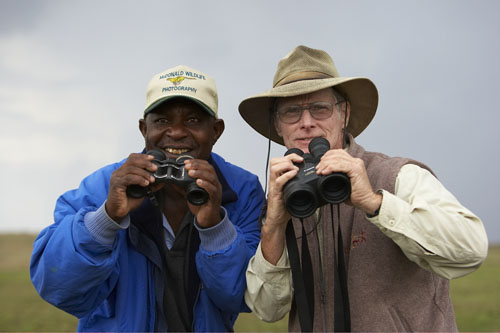
My guide, David, and me 'candidly' searching the Mara.

The following is my day-by-day accounting of a typical safari, in this case the third of the three Kenya photo safaris we did in 2007. To give our future participants some idea of what can happen in a typical day, and also for anyone contemplating doing a safari, I've recorded the actual times when I stopped to shoot. In some cases, you'll note that I just made an entry like '7:00 Gunther's dik-dik' which merely indicates that the vehicle I was in stopped to shoot a dik-dik at that time, but no unusual or noteworthy behavior was recorded. In other cases you'll see that there is some interesting field notes added. I compiled this journal each evening, adding the fleshed out notes at that time, as I rarely had the time during the day's shoot to do anything but note the time, the subject, and perhaps a brief behavioral note.
You might find some of the notes superfluous for you -- it's probably not an earth-shaking event that a bat-eared fox left the den site area at a particular time to defecate forty yards away before returning to call out the pups, but I recorded it and you'll read about it. More importantly, by far, is the fact that every safari is different, and anyone going on a safari should not expect that they'll be stopping every three or five minutes to take a photo, or that an entire morning or afternoon might be devoted to waiting on a cheetah to make its hunt, or whatever else I've recorded here that was unique to this safari.
That said, however, the following journal will give you a very good idea as to how our safari runs, what you'll expect to see, and, to a fairly accurate extent, the pace that shooting occurs. We saw a lot, and for the sake of brevity I haven't included all of the images made during the times noted. For that, I may offer an extended version of this journal as a pdf file for sale. Please inquire with our office about the availability of this pdf. In this web version, there may be spelling or typo errors - this text was written each evening, after dinner, and ... mistakes happen!
Visit our Participants' Portfolio. Read our 2007 Brochure - your reference for our 2008 and 2009 trips.
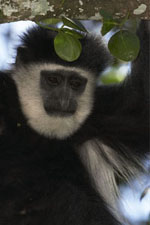 Day
1 - Depart for Samburu .Left at 8:45AM, arriving at Tree Trout,
our lunch stop, approximately 1PM. Unlike the previous two safaris,
black and white colobus monkeys were close to the restaurant entrance
and were shootable. In fact, before we were finished photographing
about 1 hour later, most of the monkeys had actually crossed through
the parking lot. A few monkeys sat atop vehicles, sometimes on
the side-view mirror, but none that I saw bothered to glance at
their reflection. Five black and white casque hornbills flew about,
tempting us while we ate lunch, as did a giant kingfisher, and
a small troop of blue Sykes monkeys passed through. A crested
hornbill pair sat atop a tree as we prepared to leave, All told,
it was the best wildlife viewing and photography we've had at
Tree Trout in a long time - an auspicious start.
Day
1 - Depart for Samburu .Left at 8:45AM, arriving at Tree Trout,
our lunch stop, approximately 1PM. Unlike the previous two safaris,
black and white colobus monkeys were close to the restaurant entrance
and were shootable. In fact, before we were finished photographing
about 1 hour later, most of the monkeys had actually crossed through
the parking lot. A few monkeys sat atop vehicles, sometimes on
the side-view mirror, but none that I saw bothered to glance at
their reflection. Five black and white casque hornbills flew about,
tempting us while we ate lunch, as did a giant kingfisher, and
a small troop of blue Sykes monkeys passed through. A crested
hornbill pair sat atop a tree as we prepared to leave, All told,
it was the best wildlife viewing and photography we've had at
Tree Trout in a long time - an auspicious start.
Day 2 - AM - Samburu. Samburu Reserve side.The first day
of organizing beanbag positioning and situating gear went fairly
smoothly, although one guy held up his vehicle when he had to
return to his tent for a second camera body - he thought he'd
just change lenses as needed, which doesn't work because of the
time factor, and also the dust. To give an idea of the action,
I kept a time log and brief notes (that I'll expound upon here)
as the morning's game drive progressed. Here's the time line:
6:21 Depart lodge
6:25-6:35 Various stops for dik-dik, red-billed hornbill, and
vulturine guineafowl, but nothing truly extraordinary.
6:45-8:00 A group of at least 30 elephants fed in the new, lush
grass and we spent over an hour filming as the herd moved towards
us, and eventually passed. A few adults came within an elephant's
body length of our vehicle.
8:13-8:23 We stopped for a flock of black-faced sandgrouse by
a small waterhole but they flew off as we tried to set up. Moments
later, as we started to drive off, another smaller flock flew
in and we shot a pair as they hurried down to the pool to drink.
We spotted a leopard tortoise nearby, but it offered no shots.
8:31 Stopped for an impala group we thought were eating the milkweed-like
plant we only see at Samburu. The does were in shade, and against
a bright background offered no shots.
8:39 Stopped for dik-dik, and in trying to get my 700mm anchored
steady on the beanbag I missed a tight headshot as the antelope
scent-marked with its preorbital gland.
8:42 Stopped for a herd of impala coming down to the river sandbar
for a drink, and for a family group of backlighted Egyptian geese,
but neither offered great shots. A harshly lit elephant drinking
and spraying water caught our attention, but offered no great
shots as it didn't continue spraying.
8:56 A few hundred meters downstream we stopped for a herd of
perhaps 30 elephants that crossed the river.
9:06 Phil and Jan stopped for a group of impalas resting in the
shade, but I didn't bother shooting as it offered nothing new.
9:18 A small group of vervets, with two babies, one quite young,
teased us, but we got nothing more than a couple of shots of the
one mother/baby pair.
9:30-9:45 Stopped beneath a sausage tree for breakfast, while
keeping an eye on a duom palm tree where some green wood hoopoes
and an orange-bellied parrot worked at some possible nest holes.
9:54-10:26 Another, slightly better elephant crossing, this one
moving straight to us, followed by two more waves of crossing
elephants, for a total of around sixty animals.
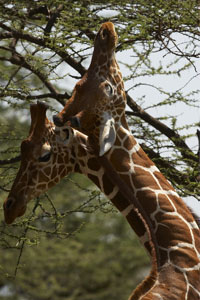 10:32
Left the elephant crossing with plans to shoot other subjects,
but …
10:32
Left the elephant crossing with plans to shoot other subjects,
but …
10:44 Another elephant crossing, this one at an overlook where
we could look almost directly down upon the closest, and upriver
where as many as three groups were crossing at any one time. Several
times there were as many as 70 elephants in view at once, and
I missed many as members of various groups moved into or out of
the forest. Apparently a female elephant was about to go into
heat because several bulls where about, one appearing to be in
musth, and we had several attempted matings, or mountings, at
least. One created quite an uproad and after the first screams
of one elephant, the entire river valley erupted with screams
and bellows and trumpets as a small herd converged on the pair.
11:30 Elephant action dissipated, with almost all of the elephants
disappearing upriver or into the forest. We headed back to camp
for lunch - it was a blazing hot, cloudless sky, morning.
11:40 Stopped for 17 reticulated giraffes near the road. A male
flehmened a female, and we filmed two young adult males as they
play-fought. Lighting was harsh, so I went with 500mm for tight
head/neck interactions.
11:50 Arrived in to camp.
4:00PM Buffalo Springs side. Left camp, and drove passed
klipspringers that must have been hidden in brush at the base
of 'klipspringer hill.' We were called back, and spent the next
20 minutes with them.
4:30-4:56 Family of klipspringers, most activity consisting of
climbing (alternately) upon a few lookout rocks. Not as close
as we've had in Tanzania, but probably best ever for Samburu.
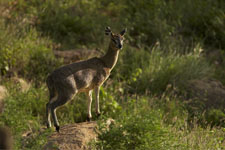 4:58-5:02
Dik-diks, feeding in low grasses. Good light, but nothing exceptional.
4:58-5:02
Dik-diks, feeding in low grasses. Good light, but nothing exceptional.
5:03 Leopard tortoise - great light, and tortoise facing us, feeding
on grasses. Eventually, the tortoise must have spotted us because
it dropped flat, while still keeping its head out, and then, as
is usual for these reptiles, it turned and headed into the vegetation.
5:15 A large flock of ringed doves and a lone hornbill attracted
our attention. The red-billed hornbill was feeding, and at first
we thought it was a grasshopper but, to our naked eyes, it didn't
look right. It was a large yellow scorpion, and hopefully, hopefully,
I hit focus in the time that it juggled it in its beak before
swallowing.
5:17 Spent nearly next 20 minutes cruising through leopard tree
habitat, but no luck in the spectacular golden evening light.
5:39 A lone bull elephant in musth - I could clearly see the green-colored,
distended like a cauliflower, dripping urine-penis, in great late
light.
5:41 Magpie starling - first time I've ever filmed one. Not as
close as I'd like, but still good.
5:54 Oryx - Richard and Gerry filmed, I didn't see anything new
that warranted the pixels.
6:00 - Colored sky, with the sun behind a cloud, but an OK silhouette
of black-capped social weaver nest tree. I didn't bother with
a silhouette of the tree, since the base was cut off by the landmass,
and instead tried to get a weaver as it flew back into the nest,
as a fast shutter speed.
6:25 Returned to camp.
Cat Tally: 1 leopard, briefly seen but not photographed.
Day 3 Samburu AM Buffalo Spring side.
All told, a fairly slow morning, but highlighted by several wonderful
mother/baby interactions. We crossed over the Usaso Nyiro River
to be in prime leopard habitat, but we saw none, nor, judging
by the silence of the monkeys, did any other primate. Here's the
time line:
6:15AM - Depart from lodge.
6:35-6:51 - A flock of green wood hoopoes clustered along the
roadside termite mound, pulling out fresh termites, including
several winged adults, which is surprising since we haven't had
rain to trigger an eruption.
7:00-7:35 - Crossing the bridge, we spied several female baboons
basking on a bridge-height tree limb, including, eventually, a
female who appeared with a few days old black baby. Good light,
good interaction.
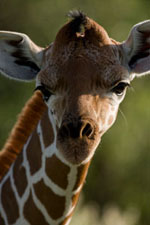

7:36-8:35 - We kept pace with, or got ahead of a mother reticulated
giraffe with a baby under a week old. At one point a male approached
and tested the female's urine, but oddly didn't flehmen, although
it did present a nice male-female-baby lineup shot. At first the
baby was a bit skittish, but as we followed it grew accustomed
to us, eventually walking to within about 12 feet of our vehicle
to check us out. The mother groomed the baby steadily for several
minutes, fortunately, because we were first out of position because
of a shrub.
8:45 Kori bustard sighted, but too far for a shot.
9:04-9:36 Breakfast at the overlook, but we had to stay in the
vehicle because of a nearby herd of elephants. As we prepared
to leave, a large male strutted toward where one of our guides
had been seated, out side the vehicle. Whether it meant business
or not, it looked as if it were swaggering to us to do some damage.
From here we headed down the Isiolo drainage, checking trees for
leopards - again without success.
10:08 Three crocodiles basking along the Isiolo.
10:17 After leaving the crocs, we almost ran over a savannah monitor.
It ran beneath a bush, and offered no photos.
10:31 A few minutes earlier we watched a pair of golden palm weavers
start a nest, but too far for photos. A trio of water thickknees
occupied us until a herd of elephants came to the river.
10:40 A mediocre elephant crossing, but in good light.
11:39 Elephant play in the river, about ½ mile from our
11:40 spot.
11:45-12:04 A fairly decent elephant crossing, with one baby having
bright pink feet, as if it were a partial albino. All four feet,
and a portion of its trunk was pink. At times we had a rugby scrum
of five baby elephants piled on top of one another.
12:10PM - Headed back to camp, arriving in at 12:50.
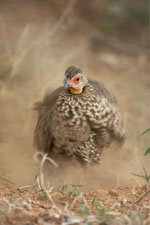 4PM:
Samburu Reserve side. Left camp, hopefully to find the normally
common leopards of Samburu. Since I was with Joe and Carolyn,
veteran safari-goers, there wasn't a need for filming the usual
Samburu species so we cruised more than we shot.
4PM:
Samburu Reserve side. Left camp, hopefully to find the normally
common leopards of Samburu. Since I was with Joe and Carolyn,
veteran safari-goers, there wasn't a need for filming the usual
Samburu species so we cruised more than we shot.
4:29 - We stopped for a pair of African sparrow hawks, red-tail
hawk-sized accipiters, but they were too far away for shots.
4:42 - Stopped for dik-dik but the shot evaporated before I could
get into position.
5:16 - To shoot something, we stopped for a yellow-necked spurfowl
perched atop a snag. Got some decent shots before the bird hopped
off the perch, but we then noticed a pair of spurfowl dust-bathing
beneath a bush. They were nearly completely covered in dust, and
I got one shot off when a noise from the vehicle spooked them
out of their dust wallow. I was setting up for another shot when,
unexpectedly, the spurfowl shook its feathers, sending a marvelous
dust-cloud that enveloped the bird. I shot, and shot again a moment
later when it repeated the shake, but I wasn't prepared - had
I a moment to set up, or had I predicted the shake - something
I will do in the future - I'd have raised my ISO and shutter speed
to freeze the action.
5:25 - Unusually erect crests on a pair of Dik-diks alerted us
to something new. We normally see an erect crest, or top knot,
on a dik-dik when a male drives off a rival from its territory,
or when fighting. This pair was doing neither, and seeing both
sexes, we correctly guessed they were attempting to mate.
Both the male and female had, as stated, erect crests, with the
male's hair raised so high that the horns were barely visible
above the hair line. The male also had flared its rump hairs,
reminding me of an alarmed pronghorn antelope. The male either
followed the female, or paralleled her back end, pausing periodically
to nudge or slap her with his foreleg (a typical antelope mating
action), licking her posterior, or trying to mount. Eventually
he was successful, and completed, the crests on both dik-diks
lowered, the male's rump hairs resumed their normal pattern, and
both moved off in independent directions - still staying together
in their territory, but no longer shadowing one another.
5:39 - Stopped to view an uncommon yellow-billed hornbill perched
on the same dead snag as a very rare rufous-crowned roller. A
birder would have enjoyed the shot, but photographically …
we passed.
We continued on searching the rocks at the base of the Verreaux's
eagle mountain for leopards, but without success.
6:00 - While we were driving, Carolyn spotted a very rarely seen
striped hyena on the hillside. We got a few record shots before
this shy animal flattened itself behind vegetation.
6:25 - Arrived back into camp.
6:50 - The blotched (spotted) genet showed up at our tent again
while we were having our personal sun-downer, and tonight I was
ready with two flashes - one slaved, one master - to catch some
portraits. It worked!
Quite unusual for Samburu, we saw not a single cat today!
Day 4 Samburu. Samburu Reserve side.
Covered a lot of good leopard habitat along the U-N River, and
one of our vans found what was probably a mating pair, but the
encounter lasted less than two minutes and the photographers got
off a total of three shots. I had a spectacular morning - as did
Mary filming a dwarf mongoose carrying a baby. Here's the time
line:
6:15 Depart camp. Headed into prime leopard country, and with
a slightly overcast sky we weren't tempted to film anything immediately.
6:47 Pale-chanting goshawk.
7:00 Gunther's dik-dik.
7:05-7:38 Vervet monkeys and their babies, and a flock of impala,
especially several juveniles that seemed curious about the monkeys
or their babies.
7:40 Somalia ostrich males in display, with one driving the other
off. The display caught our attention, but once we got into position
it had deteriorated simply to a chase.
7:50-7:54 Red-billed hornbills feeding in a flock of 7 on the
ground, presumably on termites.

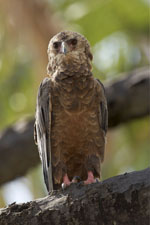
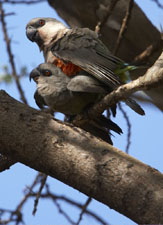
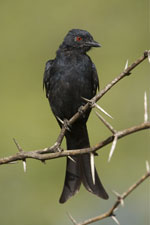
8:25-8:34 We'd been searching for a treed leopard when we received
a radio call that one of our vehicles had spotted a leopard. En
route we spotted a fairly good long-crested eagle, which we almost
passed on, but wisely we decided to get some shots before racing
off after the leopard (which proved uncooperative, anyway). Eventually
the bird flew, only to land further down the track on a far better
perch, virtually at van-level.
8:45 Fork-tailed Drongo
8:48 Another fork-tailed drongo. Both were perched close and afforded
great shots.
8:55 Olive baboon. A rather large troop were climbing some doum
palm trees, with a few young on nearby acacia trees. While waiting
for a baboon to leap from one palm to another, we spotted an orange-bellied
parrot nest.
9:00-9:31 We spent time at the parrot nest, and missed a great
shot when a lilac-breasted roller dive-bombed the male parrot
and drove it off into the trees. Eventually the female joined
him, and after an upraised wing display the two mated, in what
has to be the longest bird-mating sequence I've ever seen. Unlike
the normal, brief 'cloacal kiss' of most birds, the parrots undulated
and moved about for at least 8 minutes, if not more.
9:32 Olive baboon - with their young riding jockey-style on the
females' backs.
9:40-10:00 Breakfast, parked under an acacia in view of several
fairly large crocodiles on the other side of the river.
10:05 Baboon - tried for riding shots but the females veered off
of the trail into cover.
10:10 Elephant feeding close to the road. Close enough, and with
the contrasty light, that I tried fill-flash on the shadows.
10:30-10:50 Immature Batelur eagle in a palm. Our first view was
a neck-killing steep angle, with a bright sky to boot. After getting
some literal frame-fillers we changed position, backing off and
moving so that we had the eagle framed against a background of
palms and not sky. Still used fill-flash, effectively.
10:53-10:57 Crowned cranes.
11:05-11:27 Stopped for oryx portraits, but one feisty male began
chasing another and we were teased with several running opportunities.
Unfortunately they were moving through scattered acacias, so the
shooting windows were narrower than I'd have preferred.
11:37 Greater spotted cuckoo.
11:43 European roller.
11:57-12:10 Reticulated giraffe and red-billed oxpecker. A group
of giraffe were seated near the roadside, calmly chewing their
cud. The closest, a male, had one oxpecker working its horns and
eyes, and at 700mm the bead of the giraffe just barely fit into
the frame, and the ears did not. At 500mm the framing was better,
and I didn't feel like I lost any impact. Undoubtedly the best
shots I've made of close-up giraffe/oxpecker interactions.
12:20 Arrived back at camp.
4PM Samburu. Buffalo Springs side.
Headed out for a final, unsuccessful search for a good Samburu
leopard, without luck. Although we, or the group, encountered
three leopards in total (none on the last trip), none of these
were especially rewarding, an unfortunate turn since Samburu often
offers our best leopard shooting. Still, Samburu was a great first
stop, and this evening was quite productive. Here's the time line:
4:03 A huge savannah monitor had its head half-out of one the
hole holes in the large termite mound close to the lodge entrance,
but we missed the shot, and probably in trying, messed it up for
the first vehicle that had stopped. I felt bad, but with three
other vehicles behind us, it was inevitable that the monitor,
if spooky, would have retreated.
4:12 A trio of common waterbuck.
4:25 Leopard tortoises attempting to mate. A huge, knobby shelled
male followed a much smaller female across the track, but the
male retreated back into the brush at our approach, and the female
just retreated into her shell. I got out to move her to the roadside,
and after a minute or so she came out and walked away.
4:32 Red and yellow barbet - in a brush pile, with a bright stick
behind its head. Not the best.
4:36 Red-billed hornbill.
4:41 Donald-Smith sparrow weaver. We often find these sparrow-like
birds on the Buffalo Springs side, but I don't think I've taken
the time to shoot one on digital. The first one we shot was rather
harshly side-lighted, but I think I caught a good eye-highlight
and maybe something worthwhile, full-frame.
4:47 Gerenuk, a male scratching.
4:54 Reticulated giraffe against a wonderful cumulous cloud sky.
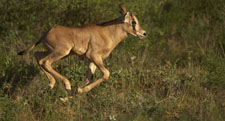 5:00-5:08
Oryx. Four adults trotted across the road ahead of us, and three
of those retrieved 3 calves, with tiny horns sprouting. They returned
the way they'd come, retracing their steps, but at the crest of
the hill the young started running, and in a wide circle returned
to the spot they'd come from. Eventually the adults headed back
in that direction.
5:00-5:08
Oryx. Four adults trotted across the road ahead of us, and three
of those retrieved 3 calves, with tiny horns sprouting. They returned
the way they'd come, retracing their steps, but at the crest of
the hill the young started running, and in a wide circle returned
to the spot they'd come from. Eventually the adults headed back
in that direction.
5:12 A side view of another Donald-Smith sparrow weaver.
5:15-5:28 Elephants in very warm, very direct late afternoon light,
but nothing worked, for me, although we saw some interesting behaviors
with calves.
5:31 A secretary bird walked straight in to us, stopping at bust-shot
distance, whereupon it gaped widely several times, and then flew
off.
5:32 Gerenuks.
5:36-5:39 Back-lighted and side-lighted reticulated giraffes against
the dark mountain background.
5:42 Stopped for a scenic of Mary's mountain.
5:52 Only ten minutes earlier, I'd commented to our driver-guide
that I hadn't seen a crested bustard on this safari. We now saw
one, displaying oddly, flapping its wings and dancing around a
bush. David thought it was playing, but I did see it chase a moth,
so perhaps the wing motion was to spook hidden insects …
but the play hypothesis seems credible, too.
6:00 Stopped for another landscape.
6:03 A pretty nice red and yellow barbet on a termite mound. Since
the light was dropping I stayed with my 500, which occupied top-to-bottom
most of the horizontal frame. With 700, the bird would have just
fit within the frame, but I didn't want to risk that slow a shutter
speed.
6:20 Returned to camp, traveling west into a gorgeous African
sunset.
That evening I tried once again to shoot the blotched genet, disguising
my bait site this time, and getting some pretty good shots. Unfortunately,
the genet came in for a briefer time, and since we were rushed
(it was Mary's birthday and we were having a special bush dinner)
a couple of items were compromised. Still, hands' down it was
my best genet shots … now I just have to wait until next
year to do even better.
Day 5 Samburu to Nakuru
Got off to a great, early start from Samburu for the 7 hours of
road time involved in getting to Nakuru. Just out of the lodge,
David's vehicle broke a spring, so we were held up in Nanyuki
while he had the vehicle repaired, with the three of us in David's
'rover going into three other vehicles until David's was fixed.
Arrived in Nakuru around 1:30PM, had lunch, and out again at 4:00PM
for the afternoon game drive.
 4:00
Nakuru. Depart lodge, and headed directly to Cormorant Point
for an afternoon of bird photography. In the three weeks we'd
been away more flamingos have returned to Lake Nakuru, and the
water level has dropped. Our drive started in a rain, and I was
afraid we'd have a washout, but by 4:45 or so the rains had passed
and we had fairly decent shooting through the rest of the afternoon.
Unfortunately, the white pelicans weren't flying with the abundance
they had on the past two trips, although it was still good, especially
for new-comers.
4:00
Nakuru. Depart lodge, and headed directly to Cormorant Point
for an afternoon of bird photography. In the three weeks we'd
been away more flamingos have returned to Lake Nakuru, and the
water level has dropped. Our drive started in a rain, and I was
afraid we'd have a washout, but by 4:45 or so the rains had passed
and we had fairly decent shooting through the rest of the afternoon.
Unfortunately, the white pelicans weren't flying with the abundance
they had on the past two trips, although it was still good, especially
for new-comers.
6:05 Left the lake shore for a cruise through the yellow-barked
acacia trees, looking for leopard, but without success.
6:25 Return to lodge.
Day 6 Nakuru
At dinner last night we'd heard of a lion/buffalo kill right beside
the road within a half mile of our lodge, and we checked that
our first thing this morning, which offered good views for new-comers
but nothing exceptional. Vehicles scattered according to varying
agendas, and some folks did very well with white rhino (normally
Nakuru is excellent for rhino), although I was with some birders
so we spent all of our time by the lake, filming birds and identifying
a lot of species. Still, the shooting wasn't bad, and here's the
time line:
7:00 Depart lodge.
7:03 Three young male lions at a roadside buffalo kill, that oddly
enough was barely eaten. Although the neck was twisted as it would
be in a kill, the meat was barely touched, as if it were a natural
death. Later in the day, when we again drove by, the lions were
feeding, but my impressions about the meat remained.
7:25 African buffalo herd.
7:57 Birding en route
8:11 Spotted first white rhinos, a mother and calf, which some
vehicles went for. We passed on it.
8:18 Stopped for Frank and Sue to photograph pelicans at the cross
dike, and to do some general birding. In the distance a Rothschild's
giraffe and baby were visible, which they shot for the record
8:34 Lilac-breasted roller.
8:38-8:40 Striped hyena, the first I've ever seen in this park.
Ironically, I've seen two on this trip, and we often go years
without spotting one.
8:45 Warthogs.
8:55 A fish eagle looked promising, and we worked it two or three
times as it moved along the lake shore.
9:00-9:30 Birding at the lake.
9:38-10:00 Another fish eagle, and this one was even better. I
was hoping to catch a shot as it launched, but each time it did
so it flew toward the lake, and away from us.
10:15 Spent some time identifying terns and shorebirds.

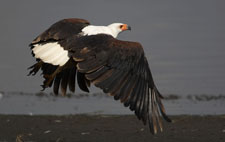
10:50 Another eagle, and this one was facing us. May have caught
the launch as the bird finally took off.
11:05 A great steppe eagle right above the road. The first views
were against the light, but after getting some insurance shots
we drove right underneath it and shot it again. I was afraid the
bird wouldn't fit into a 500 view, so I shot my insurance shots
with a 300, and it flew off before I had a chance to try with
the 500.
11:25 Auger buzzard.
11:30 Several colobus monkeys in the roadside-trees, but small,
and far-away compared to what we'd done at Tree Trout.
11:40 The three young lions were feeding on the carcass, with
the lioness on a tree on the opposite side of the road. Graphic
shots of a skin-stripped skull and feeding lions, but I passed
on the shots, though Frank and the other vehicles' shooters blasted
away.
11:55 Return to lodge.
PM As per tradition for our last trip, we visited the family
of our head driver-guide, ate ourselves to bursting, and just
had a wonderful visit. On the return, we had a nice male black
rhinoceros that sprayed some bushes. Last year, on this same occasion,
we had an African wild dog right next to the road, which I shot,
half-way decently, with a P/S camera! The rest of the group returned
to Cormorant Point for more bird shooting, but the light was more
murky and overcast tonight, so it wasn't a bad game drive to miss.
Day 7 Nakuru to the Masai Mara
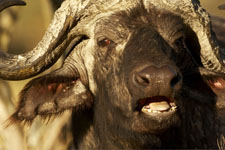 We
did a relatively short game drive this morning, since Carolyn,
Joe, and Mary were supposed to fly to the Masai Mara so that Joe
and Carolyn could avoid the atrocious road to the Mara. Fortunately,
they rode in my vehicle, because the bush pilot elected to bring
a student pilot, double-dipping his air time with Joe and Carolyn's
charter with the charge on a student pilot, so Mary was aced out
of flying down, and getting our rooms arranged early. Joe and
Carolyn flew down without incident, although the bush pilot, dumping
immediately on Mary and on our driver-guide was a jerk, racist,
sexist, and guilty as hell.
We
did a relatively short game drive this morning, since Carolyn,
Joe, and Mary were supposed to fly to the Masai Mara so that Joe
and Carolyn could avoid the atrocious road to the Mara. Fortunately,
they rode in my vehicle, because the bush pilot elected to bring
a student pilot, double-dipping his air time with Joe and Carolyn's
charter with the charge on a student pilot, so Mary was aced out
of flying down, and getting our rooms arranged early. Joe and
Carolyn flew down without incident, although the bush pilot, dumping
immediately on Mary and on our driver-guide was a jerk, racist,
sexist, and guilty as hell.
The group saw a leopard, and actually got some good shots as it
walked right by the vehicles, and also when, for about 10 seconds,
it climbed on top of a tree.
The group departed Nakuru at 11AM, taking the 'short cut' which,
this time, was quite passable, so that we arrived in the Mara
by 4:15, a record for this often arduous day of travel. Here's
the time line for a rather brief game drive for the four of us
(the rest of the group stayed in the park until 10:30AM.)
7:20 Depart the lodge, packed up and ready to travel to the Mara.
7:22 Stopped at the lion kill from yesterday morning; the lions
were still at the kill, which they had dragged into the brush.
7:28-7:38 Two good buffalo stood along the roadside, and one,
facing the morning light, was exceptional.
7:45 We stopped to watch three distant lions, we suspected were
mating, but no possibility for any shots.
8:10 Taking the forest tracks to look for a leopard for the group,
we spotted a European buzzard which glided about 70 yards to the
roadside in front of us. It looked around for a few minutes, then
grabbed a small frog that it had obviously seen from its perch.
8:12 A troop of olive baboons looked pretty good on a fallen yellow-barked
acacia tree, but one of the construction trucks frightened most
of them away. Still, we managed a couple of shots of a young suckling.
8:14-9:15 Spend most of our time cruising remote tracks in leopard
and African crowned eagle territory, but both species eluded us.
From there we headed to the gate to catch the plane, while the
rest of the group continued on their game drive.
10:00 Left Nakuru gate.
Day 8 Lower Masai Mara
AM - Although its December 2nd, there are still fairly substantial
herds of wildebeest in the Mara. On our last trip much of this
area was devoid of gnus, although just to the northwest there
were large herds. It will be interesting to see if these are new
arrivals from Tanzania, or if those northwestern gnus have moved
south. Although it was a slow day for me, the group enjoyed the
herd photography, the birds, and the lions - 12 in total, including
one lioness that was feeding upon a freshly-killed zebra.
Here's the time line:
6:15 Depart the lodge.
6:30 We stopped for three lions in the grass just prior to sunrise,
and Richard and Shelly got some nice shots in the first golden
light of dawn. While we shot, a shy black rhino trotted by in
the distance, but it retreated into a brushy lugga and offered
us no shots.
7:10 Elephants in grass - habitat shots.
7:24 Elephants in the mini-kopjes, with strong side/back lighting
to add some drama to the scene.
7:35-7:38 Gnus and zebra herds.
7:45 A great lilac-breasted roller perched beside the track, offering
frame-filling shots for R and S.
8:00 Zebras grooming.
8:23 A scenic that incorporated the gnu herds.
8:35 Another good scenic, a panorama of the herds in the golden
grass.
9:00-9:25 In a fairly large herd of zebras a couple of young stallions
acted a bit feisty, and we got some shots of kicking and rearing,
although there were some foreground zebras that blocked a perfect
view for me. Shelly got a great one when one of the zebras reared
high - where was I? In the lulls between squabbles we ate our
picnic breakfast.
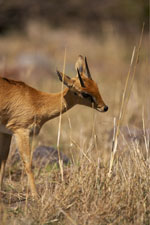 9:48
Stopped for a group of hartebeest, but the light was harsh.
9:48
Stopped for a group of hartebeest, but the light was harsh.
10:07 A scenic with a zebra and tree.
10:30 Shot the oribis at Oribi Hill, but nothing exceptional except
the male scent marked with its preorbital gland, although my framing
was a bit compromised by my lens choice.
10:36 Stopped for a very close Thompson's gazelle, which, of course,
got up and moved away just as we were about to shoot. I stayed
on it, figuring it was a territorial male that might scent mark,
and it did, leaving a black speck of tar on a stiff blade of grass.
Unfortunately, the marking occurred much farther away than I'd
have preferred.
10:45 Scenic tree and clouds.
11:00 Secretary bird
11:26 A small herd of zebras drinking and wading in a small pool,
but the angle was off and the light bad, so I passed.
11:35 Returned to camp.
PM Lower Mara
3:58 Depart from lodge.
4:14 Stopped for a huge herd, 1,000 or so, African buffalo. No
oxpeckers were closeby, so after enjoying the view we moved on.
4:30-5:00 A lone running zebra caught our eye, followed a few
seconds later by two more. Eventually a herd walked into view,
and the 'runner' was a feisty stallion that wanted to play, or
fight. Several times it would run up to another zebra and bite,
but aside from some kicks a good fight did not develop. Later,
the stallion charged repeated across the grasses - at one point
biting at another, but that was the extent of the action.
5:06 Bare-faced go-away bird on an acacia. We got fairly close
for some OK shots.
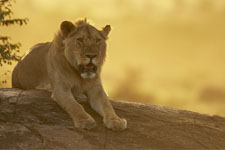 5:09-6:12
Yesterday morning, in the predawn, eight lions killed a buffalo.
By the time we arrived, nearly 30 hours later, most of the carcass
was gone, although two males and a lioness still fed half-heartedly
upon the now drying carcass. Several vultures waited, and a jackal
came in to the kill when the lions left it, to lie in the shade
of our vehicle, but the lions repeatedly chased them off. Several
hyenas circled at a distance, but with male lions present we didn't
expect any action. However, a few hyenas were advancing on the
carcass but a tourist van drove in, and probably spooked them
off.
5:09-6:12
Yesterday morning, in the predawn, eight lions killed a buffalo.
By the time we arrived, nearly 30 hours later, most of the carcass
was gone, although two males and a lioness still fed half-heartedly
upon the now drying carcass. Several vultures waited, and a jackal
came in to the kill when the lions left it, to lie in the shade
of our vehicle, but the lions repeatedly chased them off. Several
hyenas circled at a distance, but with male lions present we didn't
expect any action. However, a few hyenas were advancing on the
carcass but a tourist van drove in, and probably spooked them
off.
6:15 Another young lion lay on a rock nearby, and was backlighted
nicely. We moved into position for that for our final shots -
nice when other vehicles drove passed and kicked up dust, giving
the image a softer, ethereal look.
6:30 Returned to camp. En route, Mary's vehicle spotted a very
tame serval which her passengers shot, although the light was
low and required at least ISO 800.
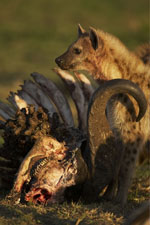 Day
9 Lower Masai Mara
Day
9 Lower Masai Mara
One of the better days we've had in the lower Mara this year,
with plenty of diversity and action. Here's the time line:
6:15 Depart the lodge, about fifteen minutes before sunrise. Clear
skies, windless, and not too cold.
6:25 Three hyenas and three jackals fed upon a fresh zebra kill,
probably from early in the night. Little remained, but one of
the hyenas carried off a leg, and another worked the hide, while
a family of black-backed jackals rather fearlessly came in as
well.
6:40 Headed back to the lion/buffalo kill, and I didn't expect
much activity, figuring that the hyenas, once the lions left,
would clean up the remainder. Two hyenas, and a pile of vultures
were still at the kill, with two other hyenas coming in to join
them. One was very submissive, raising its tail and extending
its anus (they scent mark from there); while another elicited
an attack from a juvenile. Several times the hyenas left, only
for one or another to charge back to disperse the vultures, but
eventually the vultures swarmed in, and we left before they were
sated.
7:36 Before we left the carcass we moved downwind, hoping to get
some vultures flying low, but no other vultures were visible,
and the smell, downwind, was discouraging!
9:05-9:29 Spent much of the morning driving, looking for treed
leopards or cheetahs, and found neither. Had a cooperative little
bee-eater which flew off before we could shoot, so we had breakfast
next to the perch and had success when the bird returned.
9:45 approximately. We spotted a serval, then another, and held
back to see what they'd do. Within a few minutes both came out
into the open, and proceeded to wrestle - the first time I, or
my guide with twenty-some years experience, had seen this.

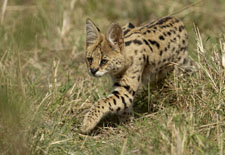
10:00 One of the servals started hunting, and was completely
oblivious to us, allowing us to get in front of it as it stalked
to within 25 feet of our vehicle. In all, the serval tried pouncing
on prey three times, and was unsuccessful each time.
10:37 Serval rested.
10:45 Serval began moving again.
11:00-11:15 The serval came close to the track again, and this
time two of our other vehicles (responding to our radio call)
where there to enjoy it. The serval leaped again, without luck,
and then headed into heavier cover farther off the track.
11:20 Left serval, started back to camp.
11:40 Returned to camp.
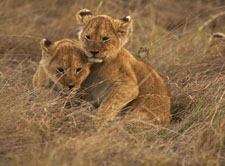 4PM
Left lodge, with rain clouds to the west just south of Serena,
but the sky was patchy clouds for the most part, so the light
was soft, but not too dark.
4PM
Left lodge, with rain clouds to the west just south of Serena,
but the sky was patchy clouds for the most part, so the light
was soft, but not too dark.
4:15 Stopped for some topi babies, but a buck Thompson's gazelle
on the other side of the road proved very cooperative.
4:44 Just prior to our leaving, the two bucks we had been watching
both urinated, then a bit later defecated, but I didn't catch
any 'spud'ing behavior as we see with pronghorn's in the States.
4:50 Stopped to check out a Nubian vulture nest, but no shots.
4:56 Black-bellied bustard.
4:59 A family of four ground hornbills, fairly cooperative but
no exciting feeding.
5:05-5:15 Pulled up to check out three lionesses, but a very cooperative
white-browed coucal distracted us.
5:26 Deidrick's cuckoo.
5:38-6:15 We received a radio call that there was a huge traffic
jam (little Nairobi) in the distance - meaning either lion or
cheetah. It turned out to be a pride of lions with three great
males, six cubs, and three lionesses. We arrived later, and could
have been out of position but the cubs walked toward us, and later
the lioness passed close by. Mary also arrived late and was just
up the track from me, and shot the cubs as they walked straight
to her, full-frame.
6:30 Arrived back at camp, a distance of 6 miles from the lion
pride, taking 17 minutes at our guide's breakneck speed of 32mph
to meet the park curfew.
Day 10 Lower Mara
AM Although the day started fast, and promising, it slowed
after the first hour of shooting. Searched a lot of country for
cheetah without luck, and we're wondering if the 'managed fires'
to generate new growth in the Mara has finally had impact, for
cheetahs often have their cubs in the high grass and, if it burns,
the cubs are doomed. Here's the time line:
6:15 Depart lodge.
6:22 Eight minutes before dawn we spotted an old black rhinoceros
close to the road and, unlike many here in the lower Mara, this
one didn't run off.
6:34 The sun finally passed over the hill and we had nice gold
highlights on the rhino, backlighted for the most part.
6:54 The rhino reached the edge of the croton bushes, was in the
shade, and appeared ready to disappear into the brush. We left
it go.
6:57 One, possibly two servals hunted about 70 yards from the
track. Minimal shooting opportunities.
7:10-7:20 A lioness with three cubs sat atop a small hill for
a short time before slipping back into the brush. While we watched,
a wattled plover called her just-hatched chicks, giving a peculiar
whistle whenever she wanted them to hunker down, whereupon they
disappeared on the kopji rock face.
7:54 A very close, very tame lilac-breasted roller.
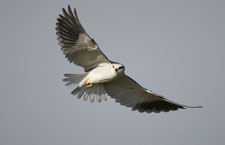 8:20
A perched black-shouldered kite repeatedly elevating its tail
caught our eye, it took off, hovered, and returned to the same
perch. It flew as we drove closer, but hovered and circled us
several times, making for good shots.
8:20
A perched black-shouldered kite repeatedly elevating its tail
caught our eye, it took off, hovered, and returned to the same
perch. It flew as we drove closer, but hovered and circled us
several times, making for good shots.
8:25 Gnu herd silhouettes with glowing beards.
8:32-8:38 Gnu herd shots.
9:09 A small zebra family but NS (no shots).
9:14-9:41 Stopped for breakfast at our usual overlook at Oribi
Hill.
9:49 Four oribis, but they were shy today in contrast to the other
days we've filmed them here.
9:55 Elephants in the shade of an acacia.
10:08 Elephant and calf.
10:12-10:21 Mother giraffe and baby - the baby ran for a short
time to catch up, which we were waiting for.
10:24 Two females, one male ostrich, with 31 chicks of varying
ages - none small, and some much larger than turkeys. We suspect
some of these were from the pair we saw on our last trip, with
17 chicks in tow.
10:36 Nine sleepy lions in the shade.
Four miles from camp we headed in, arriving just after 11AM.
11AM returned to camp.
PM Lower Mara, Kissinger Tree area
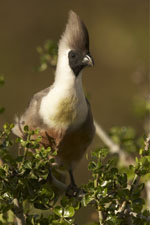 For
most of the group it was a bird afternoon, although two lions
unexpectedly killed a topi fairly close to the main road shortly
before we started our game drive. Folks saw their first bat-eared
foxes, and hopefully we'll see more in the upcoming days. Here's
the time line:
For
most of the group it was a bird afternoon, although two lions
unexpectedly killed a topi fairly close to the main road shortly
before we started our game drive. Folks saw their first bat-eared
foxes, and hopefully we'll see more in the upcoming days. Here's
the time line:
3:58 Depart from lodge, heading north into mixed cloudy skies.
4:00 Egyptian Mongoose ran across the road.
4:15-4:25 Black-shouldered kite, but against a bright sky, with
the bird in shade, so fairly marginal.
4:30 Old leopard kill, of impala buck hanging from a tree.
4:44 Another Egyptian mongoose, this one stayed in view for a
long time - in brief glimpses, but we didn't get a shooting opportunity.
4:50-5:10 Bare-faced go-away bird. Best ever. One bird was perched
in a van-height bush, the other in another shrub down in the lugga.
We moved in three times, each time getting closer, and the bird
was unfazed. After it preened it flew off, but its mate had clambered
into the shrub by then and took its place on an even closer perch,
giving us full-frame shots of both with 500mm's.
5:15-5:30 Wattled plover and white-browed coucal, both close,
with the coucal being exceptionally tame and in the open - so
close that I couldn't shoot with my 500mm.
5:31 Reedbuck - one darted off before we could set up, and the
other stayed frozen.
5:35-5:50 Eland. Normally shy, one of the bulls was completely
tame, while its two companions were a bit more skittish, running
- parallel to our vehicle - for some great running shots, full-frame.
5:52 Since we had the insurance shots in the can, we tried for
very close black-shouldered kites - which often will remain perched
late in the day. We were a click away from getting a shot when
the bird flew off.
6:05-6:10 Grant's gazelle attempting to mate, head reared back,
erection at the ready, but every time the buck started a lunge
the doe scampered a few feet ahead.
6:15-6:20 Two young adult topi males sparred half-heartedly, with
the one butting the other until it finally gave in to play and
started their fight.
Day 11 Lower Mara to Serena
Packing for our transit day/game drive went smoothly, and we left
the lodge at 6:10, heading toward the Sopa area for another chance
at cheetah. Clear skies, windy, and rather cold. Pretty successful
day. Here's the time line:
6:10 Depart lodge.
6:40-6:55 Our guide spotted a hartebeest chasing something small,
which we guessed may have been a cat, and he actually guessed
it might be a carcal, which it turned out to be. The cat darted
into the lugga, but apparently needed to get uphill so after a
few minutes it came back out and headed uphill, through the open
country. The hartebeest kept pace, and we kept an eye on it as
we drove over to try to get a shot. We lost the exact location,
but the hartebeest walked right up to the cat, looking down, practically
pointing at it. When we approached the carcal bolted back to the
lugga, with the hartebeest in pursuit, so shooting ops were very
limited!
7:05-7:22 Common zebras chasing one another lured us over, but
the activity ended before we arrive, so we shot a rather unsteady-legged
baby zebra and mom.
7:42 Two lionesses with a gnu kill, with one dragging the carcass
into the brush, pretty much straight at us for a few shots, which
disguised the mangled, half-eaten body.
8:10 We spied three vans together, and from 1.06 miles away I
thought I saw three cheetahs, which turned out to be one, but
not exactly where I thought it was - so who knows what I saw.
Fat, huge male, offered some portraits, but I assured my folks
we'd likely get much better later. Still, I had them do insurance
shots, just in case.
8:22 Five young jackals and both adults, but rather shy.
8:25-9:00 Breakfast, while we waited for the traffic jam at the
cheetah to dissipate.
9:10 Returned to the cheetah for some better shots, but not much.
10:50 The four oribi were at Oribi Hill, and again they got up
at our approach. As another vehicle arrived the three does ran
off, and I missed getting ready in time. The male would follow,
and hopefully we all got some nice shots as it bounded in front
of us.
11:00 Two fat, sleeping lions. No shot, and we heard a great radio
call, so we abandoned the cats.
At 11AM Mary spotted a wobbly, wet new-born Thompson's gazelle
not far off the track. The baby was standing, then sat, while
the mother moved off to begin contractions, eventually partially
expelling her afterbirth. She lay down to consume it.
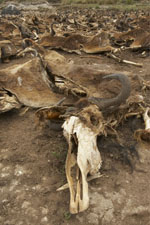 11:09
Baby sitting up, mother still eating afterbirth.
11:09
Baby sitting up, mother still eating afterbirth.
11:20 Baby got up, attempted to nurse but did not find nipples,
then wandered off. Still wobbly, but tried running , and returned
to mom periodically.
11:29 Baby lay down.
!!:29 Baby got up! Resumed its learning curve of walking.
11:34 Mom and baby wandered away from the track, getting further
out of camera range so we left them go.
12:10 Mara Bridge. Stopped for some river scenics, and another
over-view of the gnu carcasses piled along a former river eddy.
Phil and Donna needed a rest stop at the checkpoint, so I walked
down to the lower bridge for a closer view, decided to get my
16-35 and get close to the skeletons/carcasses for some hyperfocal
carnage shots. On our last two trips the stench from the fresher
carcasses prevented this, but now it was barely tolerable. None
the less, when we arrived later at the lodge I immediately took
a shower to get rid of any residual smell.
12:23 Headed from bridge to lodge.
12:55 Arrival at lodge.
PM Mara Triangle
December 5 and gnus are still in, and this evening we had our
first crossing for this safari. Remarkably, when we first started
coming to Kenya gnus entered the Mara some time in June or July,
and generally left by mid-September. Now, there's no predicting
either date - especially the departure. Here's the time line:
4:05 Left lodge.
4:18 Huge male crocodile on opposite bank of Mara River, probably
15 ft long, although estimates, always over, were 20 foot or so.
4:22 Gray heron.
4:25 More large crocodiles on the bank, but nothing striking for
an image.
4:30 Little bee-eater - frustrating, could have gotten a shot
but further than I'd like, and they flew off before we could get
closer.
4:33-4:45 Banded Mongoose troop - much more active and mobile
than usual, so shooting was marginal. One caught a snake, and
both Mary and I got distant shots. They moved into the brush when
we approached closer.
4:47-4:55 Young lioness - perched higher on a bank, it presented
ok portraits and then moved onto the flats where Richard did some
nice 600mm portraits, backlighted. Beautiful shots, but I saw
nothing really new for me so I passed.
5:05 The family of five baby bat-eared foxes (and adults) moved
their den since are last safari, into a very open termite mound.
The babies were out but were doing nothing (although Mary got
some grooming later when a few approached the male), so we headed
to the Mara River again because a group of gnus were headed toward
the shoreline.
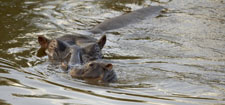 5:15-5:24
Gnus at river. Baboons along the bank occasionally ran at the
gnus and since their outline looked sufficiently like a lion's,
it spooked the gnus from crossing. Several came close, but each
time the baboons spooked them. As the gnus finally moved off,
three crocodiles appeared, and I'm sure we'd have had a snatch
if the gnus would have stayed, since the water was deeper here.
5:15-5:24
Gnus at river. Baboons along the bank occasionally ran at the
gnus and since their outline looked sufficiently like a lion's,
it spooked the gnus from crossing. Several came close, but each
time the baboons spooked them. As the gnus finally moved off,
three crocodiles appeared, and I'm sure we'd have had a snatch
if the gnus would have stayed, since the water was deeper here.
5:30-5:55 Hippo and baby. Several baboons surrounded a hippo onshore,
which we found odd, until we discovered the hippo was shielding
a tiny baby. After a few minutes the mom, and baby, slipped into
the water, and we were surprised at how adept the baby was, moving
away from mom for periods of time before rejoining her. We shot
multiples of the baby near mom's head, although the light, and
the ISO, were marginal.
6:03 The gnus had moved up to the traditional gnu crossing area,
and after some milling about one, then 2, 3, 4, and a bunch gathered
at the shoreline, and almost immediately began to cross. We'd
radioed as they gathered, so our other vehicles arrived before
the crossing was completed.
6:13 Crossing ended, and we headed for camp.
6:23 Return to camp.
Day 12 Mara Triangle
The morning was a potentially frustrating option of one good thing,
or another, depending upon where one wanted to spend time waiting.
Gnus, here on December 6th, were again congregating to cross the
Mara River, while our bat-eared fox pups and family were sitting
outside their den. We split the group to cover both spots, insuring
we did not miss the crossing. Here's the timeline.
6:10 Depart lodge
6:40 Bat-eared fox den. I picked the wrong side of the termite
mound to start, as the pups and dad were sitting on the clear
side of brush. We changed quickly, and started shooting.
6:50 The fox family was doing little more than sitting and taking
in the sun, so as the gnus began to mass by the river all of us
headed over, just ¼ mile away.
6:57 The gnus moved off, milling about in what promised to be
something of a wait. Mary's group stayed at the river, and I headed
back to the fox den. I was hoping to determine some sort of activity
pattern - were the pups so active at night that they're simply
sleeping through the morning, before retreating inside their burrows?
Or would they periodically start playing? I didn't know.
7:30 Ate breakfast while waiting on the fox. Intermittent so-so
shooting, although the light was perfect, the foxes did little.
8:00 Minimal activity, and another herd of gnus advanced toward
the rier.
8:37 Crossing looked eminent so we headed for the crossing again.
8:45 Gnus milled about, with nothing immediate.
9:00 Returned to fox den, with little activity.
9:07 First gnus walked to the river's edge, crossing about to
occur, so we raced back down again!
9:08 Crossing began - drawing in others from the area for about
a 1,500 count.

9:15 The east side of the Mara was empty, so we headed toward
the fox den.
9:20 Shot backlighted and dusty herd masses.
9:26 Returned to fox den. No pups visible, and we suspected they
had retired for the day.
9:30 Left den, headed upriver to the hills to look for cheetah.
Very slow morning, with the two shooters with me uninterested
in elephants or most subjects, so we looked for cheetah and serval.
None of the vehicles saw either.
11:04 A male ostrich displayed near the road.
11:15 A huge string of gnus crossed the road in front of us. We
passed through, and turned to shoot as gnus ran by, veering around
some obstruction that spooked them. We shot a lot of frames, using
fast and slow shutter speeds, but I ended up keeping very little.
11:26 Returned to lodge. While we didn't shoot much in the 1.5
hours after the den, we saw plenty - warthogs, elephants, topis,
a few birds, great acacia parkland, but nothing leapt out at us
for an image.
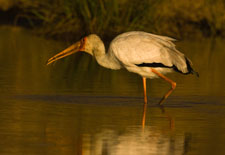 PM
Slow afternoon for everyone, but beautiful sunset and no rain.
The time line:
PM
Slow afternoon for everyone, but beautiful sunset and no rain.
The time line:
3:55 Left lodge.
4:30 Looking for cheetahs we passed on a road-side yellow-billed
and saddle-billed storks, and two Nubian vultures perched in a
fairly open tree.
4:45 Spotted two side-striped jackals, and as we approached one
we saw that it was at a den with three cubs, who retreated into
the den at our approach. We set up nearby and waited.
5:40 The mother jackal moved off, and, without her prompting,
we figured the cubs would stay inside the den so we headed back,
slowly, toward the lodge.
6:00 The large roadside pool had the yellow-billed stork fairly
close, so we pulled in, getting our right tires into the dip of
the berm to put us as low as we could get - achieving a near water
level view. The stork caught what looked like a clawed frog, perhaps
two, in nice golden afternoon light. While we shot, a group of
zebras came in and drank, giving great headshots.
6:15 Left pond, and arrived back to camp at 6:28.
Day 13 Mara Triangle
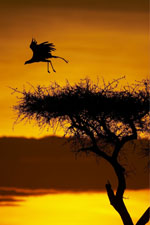 AM
- Headed for the bat-eared fox and for cheetahs, but it turned
out to be a lion day. The time line:
AM
- Headed for the bat-eared fox and for cheetahs, but it turned
out to be a lion day. The time line:
6:10 Left lodge.
6:24 Secretary bird in acacia silhouetted against the pre sunrise
sky, with the bird flying off, parallel to the film plane, so
it may be in sharp focus as it left the tree!
6:30 Actual sunrise.
6:32 Adult bat-eared fox wakes up, goes to den entrance, and the
five pups charge out.
6:40 Adult male trotted off about forty yards to urinate/defecate,
then immediately returned to the den where it groomed one of the
babies.
6:45 All five pups retreated into hole, and the male slept.
6:55 No activity at the den, and a gnu herd was building at the
river so we departed. Two lionesses were stalking the gnus, and
although too far away to shoot, we hoped to watch the hunt.
7:10 The lionesses charged (we were still driving in) and the
gnus erupted in a cloud of dust. One did the chase, the other
lioness simply sat down and watched, and, as one might expect,
they were not successful.
7:35 Another lioness, this time on our side of the river, stalked
something - we suspect it was an eland that was on the other side
and actually out of reach.
7:40 Lioness sat down and rested - minimal shots.
8:17 We had started our search for cheetahs when we were told
about mating lions. We arrived at 8:17.
8:45 First mating, facing us for some nice shots, although not
very violent, and the female didn't swat at the male.
9:00 Second mating. One false attempt, then she moved, and they
coupled amidst roaring. Oddly, the male licked the lioness's genitals,
then flehmened, which we hadn't seen before.
9:15 Third mating.
9:30 We thought the female was soliciting another mating but instead
she walked off, with the male following, until they reached the
cover of the forest.
9:31 Headed out, unsuccessfully, to find cheetah.
11:00 It was a hot, cloudless morning, and game was scarce. To
climax the morning, I took Scott and Krista and Gerry on a foot
safari, through the croton bushes along a path that led to a hippo
overlook. Our trail followed the tracks of other hippos, and we
ducked down periodically to look, at knee level, through the brush
for the legs of a hippo, buffalo, or lion. We've seen the former
two in these bushes in the past.
Most of the hippos entered the water at our approach, but put
on a good shot from there, with one female, protecting her young
calf, by charging at and biting another hippo.
11:30 Left pool and drove along the river watching for more gnu
crossings, but the shorelines were empty.
11:50 Returned to lodge, to find Mary as tired as I.
PM Mary and I had decided we'd go for the bat-eared
foxes together if the light was worthwhile, and otherwise we would
stay in an get some much needed rest. As it turned out, several
other people decided to take advantage of a rest, or to do editing,
and stayed in as well. Three vehicles went out and two of them
found a lone, very well-fed cheetah, but the light was low - ISO
800 at 1/250th or so. An hour before we were to depart our first
rain while in the Mara arrived, and through the evening it continued.
We were happy we took the rest day, and we got a lot of computer
work done doing so!
Day 14 Mara Triangle to Upper Mara area
Rain continued off and on through the night, so we had a cooked
breakfast and a late departure to give the infamous Triangle black-cotton
soil tracks a chance to dry.
7:30 Depart lodge. Low clouds hung on the escarpment and much
of the Mara River valley, and escarpment base, was shrouded in
low fog. Pretty visual but more cerebralchrome than image.
7:42 Secretary bird pair. Skies breaking and the sun begins to
shine.
7:50 Spent some time with a zebra herd, hoping for some play-fighting,
but no luck.
8:00 Sue sees her first Verreaux's eagle owl, but the bird, an
immature, was skittish and didn't allow a close approach.
8:05 Topi mother and baby.
8:07 Elephant herd.
8:15 Lion on a distant hill. One of our vehicles went there, where
there were a total of 8 lions. Apparently there was a kill, and
one of the lionesses chased jackals, which was the morning highlight
for those folks.
8:34-8:45 Lioness on a bank that appeared shy, so that when we
approached she crouched and stared, giving an intent, 'I'm going
to eat you' look, the same she'd have if focused for a hunt. Good
shots. A malachite kingfisher and a couple pairs of nesting little
bee-eaters were nearby, and Mary set up at a nest hole but the
birds zipped inside without pause.
8:57 More lions on far-off rocks, and a vulture silhouette.
9:03 Bat-eared fox den with two-thirds grown pups, but in a remote
location and shy, retreating into their burrow.
9:07 T. coursier.
9:57 Spotted hyena.
 10:00-10:22
At the hyena clan area, one very curious hyena repeatedly circled
my vehicle and then Mary's, giving folks an opportunity for tight
headshots.
10:00-10:22
At the hyena clan area, one very curious hyena repeatedly circled
my vehicle and then Mary's, giving folks an opportunity for tight
headshots.
10:24 A very rare Egyptian vulture with a mixed group of vultures,
perhaps at a finished hyena kill. The vultures took off and swirled
in a great kettle right above our heads.
11:00 Reached Mara bridge, and entered the Masai Mara side of
reserve.
11:15 Stopped for malachite and woodland kingfisher sightings,
and several scenics.
12:10 Arrive at camp.
PM Heavy clouds built in the afternoon, with scattered
showers about, and we started the game drive with the lids on
the vehicle as we expressed to a leopard kill.
4:00 Left camp.
4:15 The leopard, Bella, climbed down the tree at our approach
and we weren't sure, from the viewing distance, whether or not
this would be a tame leopard. It was and she sat down a few yards
from the tree, and eventually we moved closer for full-body shots.
While we shot a raging storm came in and the leopard moved to
the shelter of a small bank overhang, which we drove to for some
tight, leopard-in-rain portraits. Hoping she'd return to the kill
(despite a contrasty bright sky background), we backed off and
waited, but as the light failed, we decided to leave early for
camp.
5:50 Depart for camp, but en route Joshua's Toyota failed to negotiate
the steep bank at the Talek river and had to be towed over the
crest by one of the landrovers.
6:20 Arrive in camp.
Day 15 Upper Mara
Although the leopard rain ended at dinner, it resumed around 10PM
and continued, in varying intensity, throughout the night. Lightning
struck repeatedly, sometimes frighteningly close to our tent,
and we questioned whether, in the past short rainy seasons, we
had had such violent storms. At any rate, the lightning produced
an unexpected surprise on our game drive.
7AM Left camp late, postponing by one hour because of the wet
conditions and darkness, although by 7AM the sun had risen high
enough that, although obscured, we still had ISO 800 1/500th sec
speeds.
7:07 Lioness flopped in grass.
7:18 Honeymoon lion pair, but with full bellies, so we wondered
if the honeymoon was over.
7:22 A very white maned gnu, beard and mane, traveled alone towards
the Talek. We followed, hoping it might encounter some other lions.
7:25 The gnu trotted within stalking distance of the other two
male lions that own this pride, but they showed no interest.
7:36 Gnu reaches Talek, we discontinue following.
7:45 Photoed a very wet blue-napped mousebird. Mary, in her vehicle,
filmed a cluster of the same bird huddling on a tree.
7:55 Photoed a female bushbuck across River.
8:19 A very fat-looking lioness that we thought was hunting moved
into cover. We later discovered why she was fat…
8:43 A lioness sat next to at least three Thompson gazelle carcasses.
Some, we later discovered, were eaten, probably the meal of the
8:19 lioness. Joshua found a dead Grant's gazelle and two other
Thomies, so we suspect that several gazelles were killed by lightning,
probably standing in a pond-like wet savannah, where electrical
conductivity zapped them.
Two hyenas appeared, and these were later joined by several more,
which began an almost wild dog-like ceremony, as if prepping themselves
for action.
9:05 We moved farther back to allow the play to unfold.
9:10 The hyenas quickly worked themselves into a frenzy, whooping
and cackling, and charged in, to steal two partially eaten carcasses.
At this point, the lioness which had not been eaten decided to
carry her remaining, virtually uneaten carcass away and moved
into higher grass.
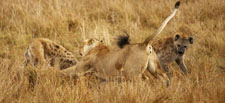 9:20
Seven hyenas circled and mobbed the lioness, never making contact,
but coming close. The lioness roared and snarled and charged,
knocking one hyena over, while the others darted in and snatched
the now unprotected carcass. They ran off, the lioness did not
give chase, and the hyenas then proceeded to fight over and chase
one another for possession of the carcass.
9:20
Seven hyenas circled and mobbed the lioness, never making contact,
but coming close. The lioness roared and snarled and charged,
knocking one hyena over, while the others darted in and snatched
the now unprotected carcass. They ran off, the lioness did not
give chase, and the hyenas then proceeded to fight over and chase
one another for possession of the carcass.
9:28 Little remains, with several hyenas and two jackals milling
about for scraps.
9:45 Discovered another bat-eared fox den with babies almost as
tiny as the ones we had seen on our last safari, but they darted
into a hole and the parents ran off.
10:10 Spotted a Thompson gazelle with an injured foreleg, who
ran off in a limb.
10:26 Flushed a Harlequin quail and managed some snapshots.
10:30 Wire-tailed swallow.
10:35 The double-crossing hippo corner had a pod of twenty or
so hippos on the bank, including a young one in good light that
passed beneath its mother's chin several times. At one point,
two Egyptian geese started making a fuss, opening their wings
wide and honking as they moved towards the hippos, which panicked
and crashed into the water - all 50,000 pounds of them!
11:15 Left hippo pool.
11:35 En route home we passed the two male lions and the honeymoon
pair again, but the light was now high and harsh.
11:50 Returned to camp.
PM Upper Mara
4PM Depart camp
4:25 Vulture activity caught our attention, which we suspect was
a cheetah kill. A white-headed vulture was in the group.
4:30 Donna spotted some canines which proved to be a family of
bat-eared foxes. The four babies were timid but the adults were
very tame, and spent several minutes grooming one another before
returning to the den - close to us, where they curled up to sleep.
Periodically the young pups would surface.
5:04 With little activity at the den, we headed towards cheetahs
that were spotted about four miles away, close to the Govenor's
camp airstrip.
5:16 Three cheetahs, mother and two cubs, but they'd eaten and
were very lethargic. A Thomson's gazelle passed fairly close by,
and they showed no interest.
5:47 Heavy rain clouds toward the Aitong Hills threatened our
return through the Stinky Water Pass, so we headed for camp.
6:00 A baby Thompson's Gazelle stayed huddled in its protective
curl for some frame-filling shots.
6:08 Stopped again at the bat-eared fox den. One of the adults
had moved since we'd left, and either the other adult, or pups,
were just barely visible above the den site.
6:25 Returned to camp.
Day 16 Upper Mara.
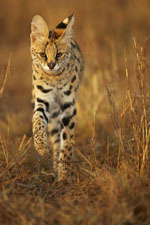 Clear
skies, with fog hanging in the valley, but otherwise a wonderful
morning to start. As it turned out, because we encountered a hunting
cheetah, we skipped lunch and stayed out all day.
Clear
skies, with fog hanging in the valley, but otherwise a wonderful
morning to start. As it turned out, because we encountered a hunting
cheetah, we skipped lunch and stayed out all day.
6AM - Left camp.
6:15-7:00 We were called back for a tame serval, and glad we went
for it proved to be the tamest we've seen in this part of the
Mara. We saw it catch a frog and eat it, and had it walked right
to our vehicles several times.
7:04 Stopped for half-hearted Thompson's Gazelle play-fights,
but they dissipated quickly. While watching, we heard a hyena-like
noise, the roar of a courting Masai ostrich.
7:30-8:36 In a soupy fog we arrived at the mother cheetah and
two cubs we had yesterday afternoon. Some great portraits of the
family, including some shots done backlighted in the fog.
8:37 Moved back to road and ate breakfast.
9:06-9:26 Mary's vehicle had spotted a great black-maned lion
walking through the grass near Govenor's camp, and we got there
to intercept several straight-on sequences. A great lion.
9:35 Returned to the cheetahs, which showed slight interest at
hunting, so we stayed back and waited.
12:51 Assembled the vehicles so that those who wished to go back
to camp for lunch could do so. Three vehicles remained behind.
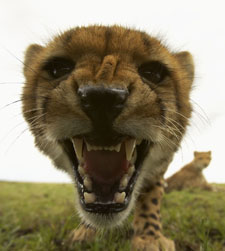 2:45
Suspending my camera out of the window by two camera straps snapped
together, and using a remote release, I did some fun ground-level
shots of the cheetah cubs as they approached the car. By accident,
the lens rotated to 16mm (I'd set it for 35mm), but the cheetahs
came so close that the shorter focusing, and wider perspective,
worked better with 16mm.
2:45
Suspending my camera out of the window by two camera straps snapped
together, and using a remote release, I did some fun ground-level
shots of the cheetah cubs as they approached the car. By accident,
the lens rotated to 16mm (I'd set it for 35mm), but the cheetahs
came so close that the shorter focusing, and wider perspective,
worked better with 16mm.
3:20 Cheetahs lost interest in the vehicles (the mother jumped
onto one of the hoods for a few minutes), and the cubs, and mom,
began to play, racing about and tackling one another.
4:15 Cheetahs started approaching Thomies for a hunt, but failed
to flush out a young fawn and didn't do any serious running.
5:06 After nearly twenty minutes of cheetah inactivity, we decided
to check out the bat-eared fox den and left the cheetahs. Mary
and the other vehicles remained behind, and the cheetahs did a
short chase of reedbuck and also of hare, and the group got some
nice portraits of the cats on a log.
5:36 Arrived at fox den, with one adult about fifty yards away
and the other in the hole. Not much action.
6:05 Adult returned to hole.
6:12 Female left den, greets male. Shortly afterwards both trot
off. Faint calling, as if to entice the shy pups to follow.
6:15 Adult returns to den and one pup emerges, but loses confidence
and ducks back inside. We decide to leave them be.
6:30 Return to camp.
Day 17 Upper Mara
Last evening an ominous storm to the east threatened our bush
dinner, but that storm passed to the north and we expected clear
skies this morning. Instead, more rains came during the night
and, even at 5AM, we had rain. Leaving for the game drives, it
looked as if we were about to do a night drive - it was dark.
6:16AM Depart lodge. We opened the roof, and had no rain. To the
east, small patches of sky promised a breakening day.
7:15 We drove straight to the burned fields where we had left
the cheetahs, and the light improved as we went. Found a freshly
killed Thompson's buck, killed by a cheetah, and we assumed it
was the family of three.
7:20-7:36 Spotted hyena den, with odd male/female interaction,
but not enough separation or defined behavior for a shot. Got
the radio call from Mary - they'd found the cheetahs.
7:45-7:55 The three cheetahs were in the marsh, the two cubs running,
mom walking as if she had somewhere to go.
7:59 Cheetahs flushed a herd of waterbuck and, perhaps, impala,
and the mother missed a kill by inches.
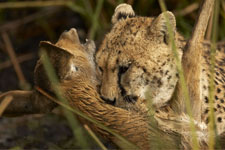 8:33
Cheetahs continued moving across marshes and grasslands near the
'Lake Nakuru' area, pausing several times on fallen logs for some
nice portraits. The two cubs flushed a female reedbuck and took
chase, but a flushed hare distracted them. Seconds later the mother,
leaping from one grassy tussock to another, flushed a large reedbuck
fawn, and in mid-leap shifted directions 90 degrees and in a bound
caught the fawn. We heard the bleets of the fawn, raced over,
and saw the struggle - with the female and fawn thrashing about
in the water of a small luggage. That's the first time I've seen
a cheetah killing in the water, or killing a reedbuck.
8:33
Cheetahs continued moving across marshes and grasslands near the
'Lake Nakuru' area, pausing several times on fallen logs for some
nice portraits. The two cubs flushed a female reedbuck and took
chase, but a flushed hare distracted them. Seconds later the mother,
leaping from one grassy tussock to another, flushed a large reedbuck
fawn, and in mid-leap shifted directions 90 degrees and in a bound
caught the fawn. We heard the bleets of the fawn, raced over,
and saw the struggle - with the female and fawn thrashing about
in the water of a small luggage. That's the first time I've seen
a cheetah killing in the water, or killing a reedbuck.
The fawn was sufficiently stunned for the young to take over,
and it tried getting up a few times but one of the cubs took a
throat hold, and the other started gnawing on a hind leg so the
fawn died quickly.
Mary radioed that her vehicle had slid sideways on the road and
was hopelessly stuck (eventually an Intrepids vehicle pulled them
out), and another vehicle of our's drove to their rescue, but
were called back for the cheetahs. Unfortunately, the driver took
the more used route through the swamp, rather than the fresher
tracks we'd used, and got stuck.
8:52 Left the cheetahs to rescue the other vehicle.
8:55-9:20 With the help of two towing cars we extracted our third
vehicle from the mud.
9:29 Ground hornbills. Stopped by the cheetahs, who were still
feeding on the reedbuck, and then for the next fifteen minutes
skied the black-cotton soil roads until we finally hit high ground.
9:45-10:15 Breakfast
10:33 Hyena.
 11:04-11:09
A large mob of banded mongoose ducked into a big termite mound,
and we waited five minutes, but as expected the mongooses stayed
in the mound.
11:04-11:09
A large mob of banded mongoose ducked into a big termite mound,
and we waited five minutes, but as expected the mongooses stayed
in the mound.
11:12-11:17 Grant's gazelles. Several nice bucks caught our attention,
with the larger ones holding their heads back in an arch and swaying,
as if posturing to show how large they were. Bucks would follow
one another closely, as if pushing for a fight, but no action.
11:20 Gnu with cattle egrets on back.
11:29 Lion and lioness by the road, and we're wondering if the
male was the same young ones we saw at Intrepids on the first
safari eight weeks ago.
11:50 Returned to camp.
PM Slow afternoon, and I had the serious birders with me, so
we took the time to get our birder over the top, cresting 200
species. She needed 7, and we got 10-11, finishing her day at
203 species. It had rained heavily earlier in the afternoon, and
we were wondering if we'd even be able to do a game drive, but
the rain worked to our advantage because we got to within frame-filling
distance of speckled mousebirds, a species that normally flies
off when you get close.
Day 18 Lower Mara
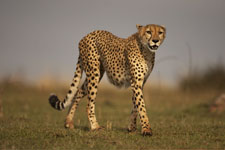 The
last day, a time of sadness, and a hope that the safari would
end with an exciting conclusion. We weren't to be disappointed.
The
last day, a time of sadness, and a hope that the safari would
end with an exciting conclusion. We weren't to be disappointed.
6:15 Depart lodge under fairly clear skies.
6:28-6:40 We found a great sunrise tree, which I've GPS'd for
future reference, and shot only the second good sunrise of this
trip.
6:41 While we were shooting, two lions we had not seen started
roaring, close to the vehicle. Another male then appeared.
6:50-7:12 Shot the second male backlighted.
7:50-8:20 We received a radio call that lions had flushed out
a cheetah, and we arrived while she was still very nervously walking
away, looking back repeatedly. I got one of my best shots of a
walking cheetah as she approached, since she was higher on the
hill than I was, and framed against the sky.
10:23 We had stayed with the cheetah and now began to show some
interest in hunting, but had already passed on several herds.
11:29 Mary left the cheetah to scout for likely Thompson's gazelle
herds, as cheetah prey, and found none. Since the group's portfolio
was due that afternoon, we decided to call it a morning.
11:36 Left cheetah.
12:06 Arrive back at lodge.
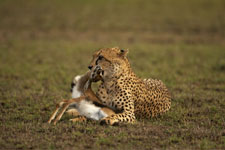 PM
Had several storms and thunderstorms pass, and we were wondering
if we'd get an afternoon, final game drive in, but the weather
looked promising. While we took our group pictures it began to
rain again, and we started the game drive with the roof hatches
closed.
PM
Had several storms and thunderstorms pass, and we were wondering
if we'd get an afternoon, final game drive in, but the weather
looked promising. While we took our group pictures it began to
rain again, and we started the game drive with the roof hatches
closed.
3:36 Left lodge.
3:50 Found the formerly 'mating' lion pair again, and the female
looked as if she might be interested in hunting, although the
disinterested male made no attempt at concealment and would probably
have blown any hunt. Still, we stayed.
4:04 David spotted a vehicle, then the cheetah from this morning,
and she looked like she was hunting, centered in an open burned
area with plenty of gazelles about. We raced over.
4:10 A female Thompson's gazelle disturbed another tiny Thomie,
and the cheetah spotted it and attacked. The chase lasted just
several seconds, and the cheetah caught the baby just out of sight.
We arrived just as she lay down with it, after carrying it a short
distance.
4:16 Began to feed.
 4:57
Cheetah consumed most of carcass and head. Since there was little
chance jackals or hyenas would now play a role, we decided to
leave. As we did so, the cheetah abandoned what was left.
4:57
Cheetah consumed most of carcass and head. Since there was little
chance jackals or hyenas would now play a role, we decided to
leave. As we did so, the cheetah abandoned what was left.
5:15 David, Carolyn, Joe, and Mary and I had our traditional end-of-safari/end-of-year
sundowner - this year, with five boxes of fruit juice. Took shots
of the five of us, and of David and I for his wall at home, and
headed home.
5:50 Drove passed the lions we'd seen earlier, where a herd of
gnus had, incredibly, just passed within a few dozens yards. The
lions showed no interest, although when we arrived we had hoped
they might follow the herd and make a charge. They didn't.
It was raining, and I positioned us so that I might get a head-on
view of a lion shaking wet fur. I missed the first chance, as
I was aimed on the male, but a shake/fight developed, and, although
I was too tight for both lions together, they came together for
this shot, all fitting in the frame. One of my favorites.
6:00 Headed back to the lodge.
6:10 Arrival back, to empty beanbags, pack camera gear, and get
ready for our last night on safari for 2007.